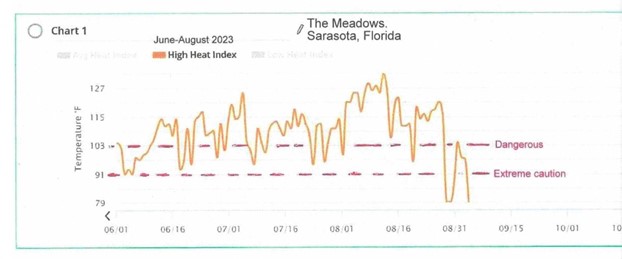Extreme Heat
Editorial Note: As this crew commentary is being posted, several countries in the Northern Hemisphere are experiencing extreme cold and snow storms. Extreme weather events are becoming more severe and more frequent. In many ways, Florida is the canary in the coal mine when it comes to our climate crisis. We can learn from their experiences dealing with extreme heat.
As a resident of Southwest Florida, understanding the dangers of extreme heat is vital. In addition to the health risks of pollution, it can damage our bodies and lungs – breathing in hot, humid air can exacerbate respiratory conditions like asthma and COPD and strain the heart.
Despite being a common occurrence every summer in Southwest Florida, extreme heat also is a broader threat to all life on planet Earth, including plants, animals and human inhabitants. In the United States, extreme heat kills more people than all other weather events combined and, therefore, should not be taken lightly!
Climate Central, an independent group of climate change scientists and communicators in Princeton, New Jersey, recently reported that “Summer 2023 was the planet’s hottest on record”. The Meadows, a Sarasota County, Florida community also experienced record-breaking heat this past summer. For much of the summer, two local Davis Instrument Vantage Vue weather stations registered heat indices ranging from 91 degrees Fahrenheit (F) to 129 F in August.
The chart below illustrates 68 days during the June-August period when the heat index exceeded 103 degrees Fahrenheit. This is the ‘threshold- temperature’ at which dangerous, life-threatening ‘heat stress’ kicks into full gear!
Because these were dangerous conditions, many outdoor activities, including golf, ceased… especially during afternoon hours.
Another Climate Central report stated that Southwest Florida experienced during the summer of 2021 an average of 25 life-threatening heat days with a heat index of 105 degrees Fahrenheit. The report further noted that this number is projected to increase to 130 days annually by 2050. It is apparent from last summer’s experience that the projected date will be reached much sooner.
While hurricanes are often given more attention due to their potential impact on human life and property, extreme heat events are just as dangerous. And, unlike hurricanes, which have a low probability of impacting anyone’s location each year in Southwest Florida, extreme heat events are certain to impact the entire state – everyone is affected. Because excessive heat is a silent killer, it is not as dramatic as a hurricane and consequently gets little news coverage. As a result, residents, especially older residents, aren’t as aware of extreme heat’s danger, namely that their body core temperatures rise, leading to heat stress illness, including heat cramps, heat exhaustion, and heat stroke… which can be lethal.
The average temperature in the Sarasota-Manatee County area has been increasing by about 0.14 degrees Fahrenheit each year since 2000. Consequently, next year’s heat events may be more extreme than this year’s record levels. Also, scientists report that this year’s El Nino event may extend into next summer, increasing the risk of extreme heat events.
For these reasons, it is essential that residents be prepared for next summer’s extreme heat events when planning their outdoor activities.
Stay aware, be prepared, and be safe!


